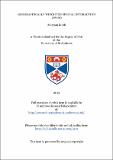Files in this item
Geographically weighted spatial interaction (GWSI)
Item metadata
| dc.contributor.advisor | Fotheringham, A. Stewart | |
| dc.contributor.author | Kordi, Maryam | |
| dc.date.accessioned | 2013-10-22T15:51:36Z | |
| dc.date.available | 2013-10-22T15:51:36Z | |
| dc.date.issued | 2013-11-30 | |
| dc.identifier.uri | https://hdl.handle.net/10023/4112 | |
| dc.description.abstract | One of the key concerns in spatial analysis and modelling is to study and analyse similarities or dissimilarities between places over geographical space. However, ”global“ spatial models may fail to identify spatial variations of relationships (spatial heterogeneity) by assuming spatial stationarity of relationships. In many real-life situations spatial variation in relationships possibly exists and the assumption of global stationarity might be highly unrealistic leading to ignorance of a large amount of spatial information. In contrast, local spatial models emphasise differences or dissimilarity over space and focus on identifying spatial variations in relationships. These models allow the parameters of models to vary locally and can provide more useful information on the processes generating the data in different parts of the study area. In this study, a framework for localising spatial interaction models, based on geographically weighted (GW) techniques, has been developed. This framework can help in detecting, visualising and analysing spatial heterogeneity in spatial interaction systems. In order to apply the GW concept to spatial interaction models, we investigate several approaches differing mainly in the way calibration points (flows) are defined and spatial separation (distance) between flows is calculated. As a result, a series of localised geographically weighted spatial interaction (GWSI) models are developed. Using custom-built algorithms and computer code, we apply the GWSI models to a journey-to-work dataset in Switzerland for validation and comparison with the related global models. The results of the model calibrations are visualised using a series of conventional and flow maps along with some matrix visualisations. The comparison of the results indicates that in most cases local GWSI models exhibit an improvement over the global models both in providing more useful local information and also in model performance and goodness-of-fit. | en_US |
| dc.language.iso | en | en_US |
| dc.publisher | University of St Andrews | en |
| dc.subject | Spatial interaction models | en_US |
| dc.subject | Spatial analysis and modelling | en_US |
| dc.subject | Spatial heterogeneity | en_US |
| dc.subject | Geographically weighted regression (GWR) | en_US |
| dc.subject | Spatial non-stationarity | en_US |
| dc.subject.lcc | G70.3K7 | |
| dc.subject.lcsh | Geography--Statistical methods | en_US |
| dc.subject.lcsh | Spatial analysis (Statistics) | en_US |
| dc.subject.lcsh | Regression analysis | en_US |
| dc.subject.lcsh | Geographic information systems | en_US |
| dc.title | Geographically weighted spatial interaction (GWSI) | en_US |
| dc.type | Thesis | en_US |
| dc.type.qualificationlevel | Doctoral | en_US |
| dc.type.qualificationname | PhD Doctor of Philosophy | en_US |
| dc.publisher.institution | The University of St Andrews | en_US |
| dc.publisher.department | Centre for GeoInformatics (CGI) | en_US |
This item appears in the following Collection(s)
Items in the St Andrews Research Repository are protected by copyright, with all rights reserved, unless otherwise indicated.

